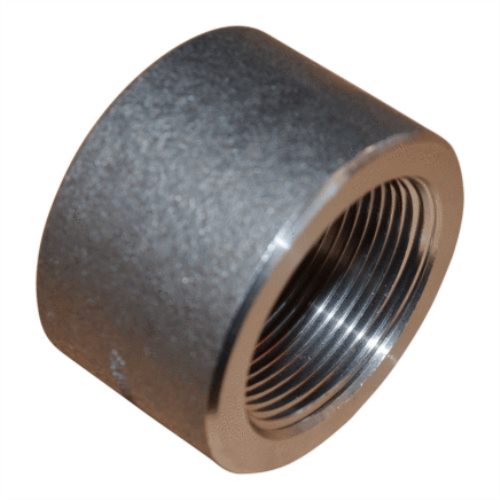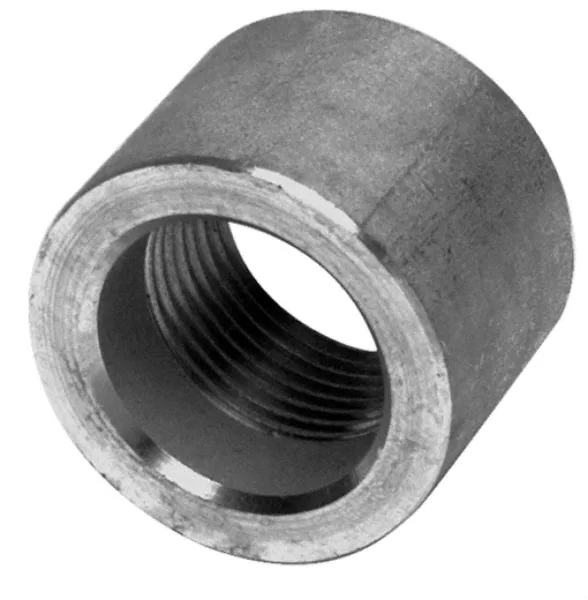Product Description
316 Stainless Steel Frmale Half Couplings NPT HangZhou FLUIDO
Product Description
316 Stainless Steel Frmale Half Couplings NPT
| Type: Close Nipple, Short Nipple, Shoulder nipple, Long Nipple, Running Nipple, Barrel Nipple etc |
| Type of pipe: Welded or Seamless pipe |
| Size: 1/8″ to 8″ |
| Length: 3/4″-24″; 19mm-500mm; Or as per customer’s request |
| Thickness: SCH40, SCH80, SCH160; CLASS A, CLASS B, CLASS C |
| Material: Carbon steel; Stainless steel: 304/304L/316/316L/321 |
| Standard: American Standard: ASTM A733 / PIPE: ASTM A53 / ASTM A106 / THREADS: ANSI B1.20.1 British Standard: BS EN15711 / PIPE: BS1387 / THREADS: ISO 7/1 DIN Standard: DIN2982 / PIPE: DIN2440 / THREADS: DIN2999 |
| Surface treatment: Black, Hot galvanized, Electro galvanized |
| Packing: Packed in cartons, then on pallet |
| Min Order Quantity: According to customer’s requirement |
| Delivery Time: 25 days after order confirmed |
| Payment: By T/T or L/C |
| Applications range:1) Petroleum, chemical industry, water conversancy, electric power, Natural gas, Coal gas, Water power and other pipeline projects. 2) Industrial pipeline system on shipping, mine, oil field, textile, powder plant etc 3) Pipeline system on subway station, railway station, airport, seaport, bridge etc |
Packaging & Shipping
1.Packing Details : carton+plywood pallets/cases+container.
2.Standard exporting cartons and plywood pallets/cases.
3. According to the customer’s requirement.
4.Delivery Details : 15-30 days after confirming order.
Company Profile
HangZhou CHINAMFG Industrial Co., Ltd. is 1 of the biggest manufacturers and exporters of pipeline products in China. We specialize in pipeline products, casting and forging (with or without machining): Malleable iron pipe fittings, ductile iron grooved fitting and coupling, 125# cast iron pipe fitting, steel butt-welding pipe fitting, steel flange, forged steel pipe fittings, stainless steel threaded pipe fitting, steel pipe nipple & merchant coupling, steel pipe, brass pipe nipple and bronze fitting, cast iron soil pipe and fitting, resilient seat non-rising stem wedge gate valves, check valve, butterfly valve, brass valve and bib-cock, scaffolding couplers / clamps, scaffolding frame & props, scaffolding accessories, pipe clamp fitting, concrete lifting anchors, lifting insert, socket & fixing insert, concrete hardware accessories, expansion shell, pipe coupling & hose clamps, radiator, cast iron manhole cover, auto parts, CHINAMFG parts, investment (lost wax casting) casting parts, die casting parts, and kinds of casting and forging machinery parts according samples or drawing from customers. All our factories are certified to the international ISO-9001 quality system standard and all products are carefully tested to meet the strict quality requirements and industry standards prior to each shipment. Parts of our products have been tested, listed, approved by some predominant labs and bodies. In order to enhance our accountability for environment, the environmental management system to ISO14001 has been assessed and registered by BVQI (France). Any information, samples and drawings which you can provide will facilitate us to make the correct supply to meet your special requirements.
Certificates
316 Stainless Steel Frmale Half Couplings NPT
/* March 10, 2571 17:59:20 */!function(){function s(e,r){var a,o={};try{e&&e.split(“,”).forEach(function(e,t){e&&(a=e.match(/(.*?):(.*)$/))&&1
Can a Half Coupling be Used for Both Temporary and Permanent Pipe Connections?
Yes, a half coupling can be used for both temporary and permanent pipe connections, depending on the specific requirements of the application and the type of half coupling used.
Temporary Pipe Connections: Threaded half couplings are commonly used for temporary pipe connections. They allow for easy assembly and disassembly of the pipes without the need for welding. Threaded couplings offer quick installation and are ideal for situations where frequent changes or maintenance are necessary. For example, during construction or testing phases, temporary pipe connections may be required before the final system configuration is established.
Permanent Pipe Connections: Socket weld and butt weld half couplings are primarily used for permanent pipe connections. Once these couplings are welded to the pipes, the joint becomes integral, robust, and permanent. Socket weld couplings are commonly used in smaller diameter pipes, while butt weld couplings are more prevalent in larger diameter pipes and high-pressure applications. These types of couplings are well-suited for applications where a secure and leak-proof connection is essential for the long-term operation of the system.
It is essential to choose the appropriate type of half coupling based on the specific needs of the application. Consider factors such as the system’s operating conditions, pressure requirements, maintenance frequency, and future changes or expansions. Temporary connections using threaded half couplings provide flexibility and ease of maintenance but may not be suitable for high-pressure or critical systems. On the other hand, permanent connections using socket weld or butt weld half couplings offer maximum strength and reliability, but they require careful planning and welding expertise.
In some cases, half couplings may be used temporarily during system assembly or testing and later replaced with socket weld or butt weld couplings for permanent operation. This allows for easier adjustments during the initial setup while ensuring a durable connection in the long run.
Ultimately, the choice between temporary and permanent pipe connections using half couplings depends on the specific requirements of the project and the balance between flexibility and long-term reliability.
What are the Differences Between Half Couplings and Full Couplings in Pipe Fittings?
In pipe fittings, both half couplings and full couplings serve the purpose of joining two pipes together, but they differ in their design and applications. Here are the key differences between half couplings and full couplings:
- Design: The main difference lies in their design. A half coupling has one end with internal threads or a socket, allowing it to be connected to a threaded pipe or inserted into the end of a pipe without threading. The other end of the half coupling is an open end, ready to be welded or threaded to another pipe. On the other hand, a full coupling has both ends with female threads, enabling it to connect two threaded pipes directly without the need for welding.
- Function: Half couplings are commonly used to create a joint between a pipe and a component such as a valve, pump, or pressure gauge. The open end of the half coupling facilitates easy attachment to the component, while the threaded or socketed end connects to the pipe. On the other hand, full couplings are used when a direct, rigid connection between two pipes is needed, providing a continuous flow path without any interruptions.
- Application: Half couplings are frequently used in situations where frequent disassembly or maintenance may be required. For example, in systems with valves that need periodic inspection or replacement, a half coupling allows for easy removal without disturbing the entire pipeline. Full couplings, on the other hand, are more suitable for applications where a permanent, leak-proof connection is needed, such as in pressurized systems or critical process pipelines.
- Length: Full couplings are typically longer than half couplings because they need to accommodate two threaded ends, while half couplings have one threaded or socketed end and an open end, making them shorter in length.
- Installation: The installation process differs for half and full couplings. Half couplings are welded or threaded onto one pipe end and then connected to another pipe or component using welding or threading, respectively. Full couplings, on the other hand, directly join two pipes with threaded ends, requiring no additional welding or threading.
- Flexibility: Half couplings offer more flexibility due to their ability to connect to different types of components or pipes with varying end connections. Full couplings are less flexible in this regard, as they can only join two threaded pipes together.
Overall, the choice between half couplings and full couplings depends on the specific requirements of the piping system, including the need for temporary connections, the type of components being attached, the nature of the fluid being transported, and the desired level of joint permanence and flexibility.
What is a Half Coupling and How is it Used in Piping and Plumbing Systems?
A half coupling is a type of pipe fitting used in piping and plumbing systems to connect two pipes of different sizes. It is a short, threaded piece with one end designed to be welded or screwed onto a larger pipe, and the other end allows for the attachment of a smaller pipe. The half coupling has internal threads on one end and a plain or beveled surface on the other end.
Half couplings are typically made from materials such as stainless steel, carbon steel, brass, or other suitable alloys, depending on the application and the medium being transported through the pipes.
In piping systems, half couplings are used for various purposes:
- Reducing Pipe Size: One common use of half couplings is to reduce the pipe size at a specific point in the system. For example, when a large pipe needs to be connected to a smaller pipe, a half coupling can be employed to create a smooth transition.
- Connection Points: Half couplings are often used at connection points where equipment, valves, or instruments are attached to the pipeline. They provide a secure and leak-proof joint.
- Repair and Maintenance: In the event of a pipe section damage, a half coupling can be used to cut out the damaged portion and replace it with a new pipe, facilitating quick repairs without the need to replace the entire pipeline.
The installation of a half coupling involves a few simple steps:
- Cutting and Preparing the Pipe: The larger pipe, to which the half coupling will be attached, is cut to the desired length, and the edge is cleaned and beveled to ensure a proper welding or threading joint.
- Attaching the Half Coupling: The half coupling is then welded or screwed onto the larger pipe end. For welding, proper welding techniques and safety measures must be followed to achieve a strong, reliable joint.
- Connecting the Smaller Pipe: The smaller pipe is threaded or inserted into the other end of the half coupling. The connection is tightened to ensure a secure fit, and sealing materials like Teflon tape or thread sealant may be used to prevent leaks.
In plumbing systems, half couplings serve similar functions, connecting different pipes or fixtures of various sizes. The installation process may vary slightly, depending on the type of plumbing materials and the specific application.
In summary, half couplings are essential components in piping and plumbing systems, enabling the connection of pipes with different diameters and facilitating repairs or adding connection points with ease and efficiency.
editor by CX 2024-02-19




